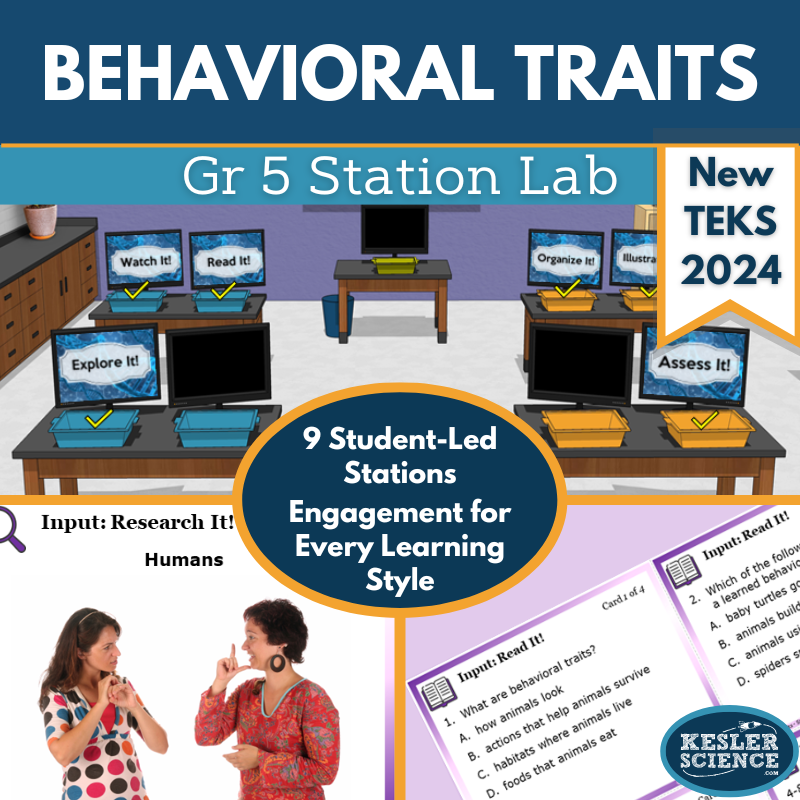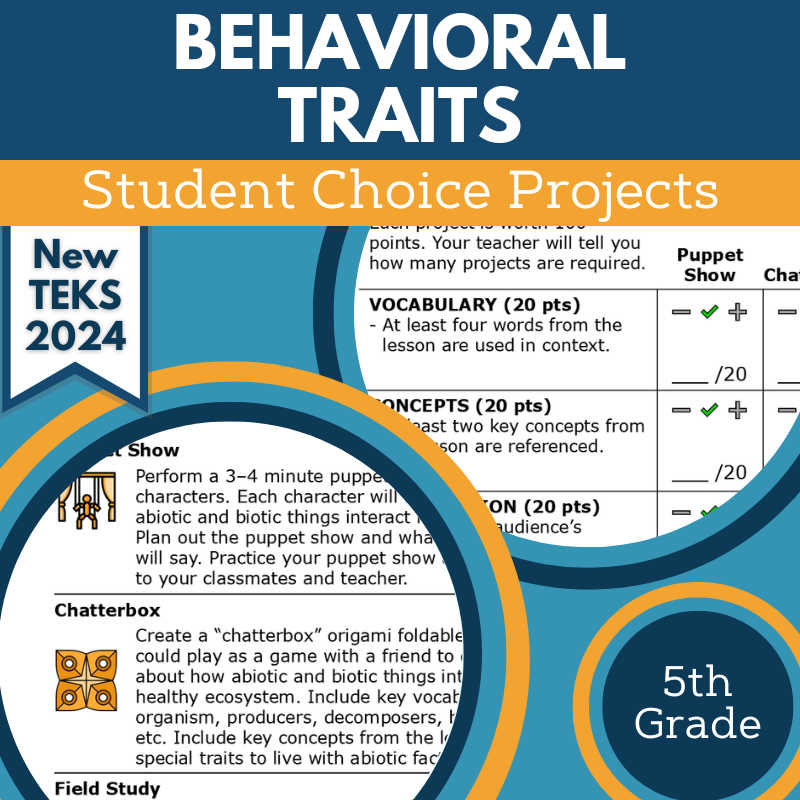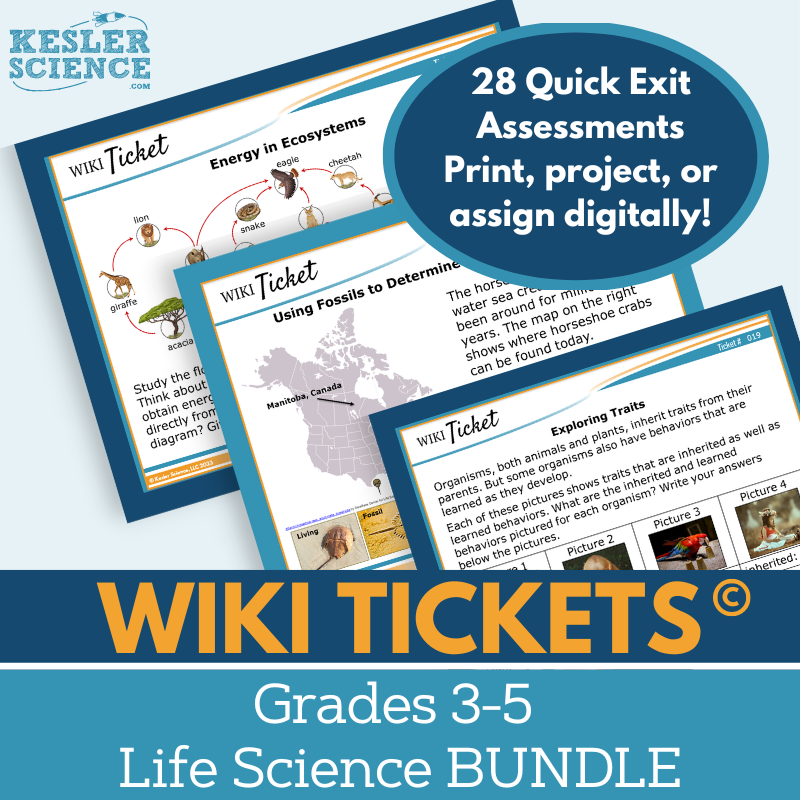Behavioral Traits Activities for 5th Grade Science
This elementary life science unit, aligned with TEKS 5.13B, explores how instinctual behaviors, like turtle hatchlings returning to the sea, and learned behaviors, like orcas hunting in packs, help animals survive. The resources below will give students a comprehensive understanding of behavioral traits. All of the following materials are also included in the Kesler Science Membership.
This elementary school life science unit explores how instinctual behaviors, like turtle hatchlings returning to the sea, and learned behaviors, like orcas hunting in packs, enhance animal survival. The lesson includes editable PowerPoints, worksheets, projects, and assessments, offering differentiated, student-led learning with minimal prep. It aligns with the TEKS 5.13B standard and is fully adaptable for print and digital formats.
In this 5E-based unit, students engage with objectives and vocabulary in both English and Spanish. During exploration, nine differentiated station labs guide students through various learning styles, including reading, research, and videos. Output stations, such as sorting, writing, and illustrating, allow students to demonstrate their understanding of instinctual and learned behaviors.
The explanation phase includes editable PowerPoints, interactive notebooks (digital and print), and note-taking templates. Students extend their learning with choice projects on survival behaviors, and assessments are aligned with STAAR 2.0. This flexible unit is suitable for both in-person and virtual classrooms, making it ideal for diverse learning environments.
This elementary school life science unit explores how instinctual behaviors, like turtle hatchlings returning to the sea, and learned behaviors, like orcas hunting in packs, enhance animal survival. The lesson includes editable PowerPoints, worksheets, projects, and assessments, offering differentiated, student-led learning with minimal prep. It aligns with the TEKS 5.13B standard and is fully adaptable for print and digital formats.
In this 5E-based unit, students engage with objectives and vocabulary in both English and Spanish. During exploration, nine differentiated station labs guide students through various learning styles, including reading, research, and videos. Output stations, such as sorting, writing, and illustrating, allow students to demonstrate their understanding of instinctual and learned behaviors.
The explanation phase includes editable PowerPoints, interactive notebooks (digital and print), and note-taking templates. Students extend their learning with choice projects on survival behaviors, and assessments are aligned with STAAR 2.0. This flexible unit is suitable for both in-person and virtual classrooms, making it ideal for diverse learning environments.
This student-led, modular station lab covers the 2021 TEKS 5.13B standard on behavioral traits and their role in survival. Designed for 5th grade life science, the lesson allows students to explore instinctual and learned behavioral traits, increasing engagement and independent learning.
The lab includes nine differentiated stations where students can interact with various activities such as videos, readings, research tasks, and hands-on exercises. The stations cover both input and output tasks. Input stations include "Explore It!" where students apply concepts digitally, "Watch It!" with a short video and questions, "Read It!" with a passage on behavioral traits (available in English and Spanish), and "Research It!" where students learn through facts, images, and graphs. Output stations encourage students to demonstrate their learning by organizing, illustrating, writing, and assessing their understanding. A bonus "Challenge It!" station offers extension activities for advanced students.
This resource is flexible for in-person or virtual learning environments and helps students personalize their learning experience.
This student-led, modular station lab covers the 2021 TEKS 5.13B standard on behavioral traits and their role in survival. Designed for 5th grade life science, the lesson allows students to explore instinctual and learned behavioral traits, increasing engagement and independent learning.
The lab includes nine differentiated stations where students can interact with various activities such as videos, readings, research tasks, and hands-on exercises. The stations cover both input and output tasks. Input stations include "Explore It!" where students apply concepts digitally, "Watch It!" with a short video and questions, "Read It!" with a passage on behavioral traits (available in English and Spanish), and "Research It!" where students learn through facts, images, and graphs. Output stations encourage students to demonstrate their learning by organizing, illustrating, writing, and assessing their understanding. A bonus "Challenge It!" station offers extension activities for advanced students.
This resource is flexible for in-person or virtual learning environments and helps students personalize their learning experience.
The Behavioral Traits Student Choice Projects align with the 2021 TEKS life science standard 5.13B, offering fifth-grade students a variety of project options that cater to different output styles. The project page includes six student-led project choices plus an option to design a custom project. An editable rubric allows for assessment by teachers, peers, or the students themselves. These flexible projects provide creative ways for students to demonstrate their understanding, with options for differentiation to meet varied learning needs. Teachers can adjust the rubric to fit grading preferences.
The resource includes a choice board with nine project options, teacher direction pages for support, and editable rubric pages that assess vocabulary, concepts, presentation, clarity, and accuracy. Two versions of the project page are available, one with modified options for remediation and one for advanced learners. The projects use standard classroom supplies like paper, markers, and scissors, with many options for digital completion.
The Behavioral Traits Student Choice Projects align with the 2021 TEKS life science standard 5.13B, offering fifth-grade students a variety of project options that cater to different output styles. The project page includes six student-led project choices plus an option to design a custom project. An editable rubric allows for assessment by teachers, peers, or the students themselves. These flexible projects provide creative ways for students to demonstrate their understanding, with options for differentiation to meet varied learning needs. Teachers can adjust the rubric to fit grading preferences.
The resource includes a choice board with nine project options, teacher direction pages for support, and editable rubric pages that assess vocabulary, concepts, presentation, clarity, and accuracy. Two versions of the project page are available, one with modified options for remediation and one for advanced learners. The projects use standard classroom supplies like paper, markers, and scissors, with many options for digital completion.
The Inherited Traits and Learned Behaviors Science and ELA Integrated Writing Activity engages 5th-grade students in a persuasive essay to test their understanding of genetics. TEKS aligned, it focuses on differentiating between inherited traits of plants and animals. The activity encourages science reasoning and enhances writing skills, and it’s designed for both in-person and virtual learning.
This resource includes teacher directions, a full answer guide, project ideas, and rubrics. It offers a projection version for classroom use or virtual sharing, as well as full-sized and half-sheet handouts for easy printing and distribution. The digital interactive version can be saved as Google Slides, allowing for flexible student engagement.
This writing prompt can be used as a cross-curricular activity, pre-test assessment, student project, or differentiation tool for early finishers. It also works well for extra credit, make-up work, or TELPAS samples. The activity can be displayed on bulletin boards or compiled into a student anthology.
The Inherited Traits and Learned Behaviors Science and ELA Integrated Writing Activity engages 5th-grade students in a persuasive essay to test their understanding of genetics. TEKS aligned, it focuses on differentiating between inherited traits of plants and animals. The activity encourages science reasoning and enhances writing skills, and it’s designed for both in-person and virtual learning.
This resource includes teacher directions, a full answer guide, project ideas, and rubrics. It offers a projection version for classroom use or virtual sharing, as well as full-sized and half-sheet handouts for easy printing and distribution. The digital interactive version can be saved as Google Slides, allowing for flexible student engagement.
This writing prompt can be used as a cross-curricular activity, pre-test assessment, student project, or differentiation tool for early finishers. It also works well for extra credit, make-up work, or TELPAS samples. The activity can be displayed on bulletin boards or compiled into a student anthology.
The Life Science Set of WIKI Tickets© offers 28 formative assessments designed for 3rd-5th grade science students. Each assessment comes in five formats: a full-screen version for projection, three handout sizes (full, split, and quarter-page), and an interactive digital version compatible with PowerPoint and Google Slides. Aligned with NGSS and TEKS standards, these assessments cover a wide range of topics, from animal groups and ecosystems to energy flow, plant growth, and inherited traits.
Each standard is addressed with at least one ticket, with some topics having multiple options. The set includes a bonus table of contents to help you navigate the alignment. The assessments are versatile for both in-person and virtual learning environments. They can be used as exit tickets, bellringers, or quick checks to gauge student understanding, offering a colorful and engaging way to track progress.
The Life Science Set of WIKI Tickets© offers 28 formative assessments designed for 3rd-5th grade science students. Each assessment comes in five formats: a full-screen version for projection, three handout sizes (full, split, and quarter-page), and an interactive digital version compatible with PowerPoint and Google Slides. Aligned with NGSS and TEKS standards, these assessments cover a wide range of topics, from animal groups and ecosystems to energy flow, plant growth, and inherited traits.
Each standard is addressed with at least one ticket, with some topics having multiple options. The set includes a bonus table of contents to help you navigate the alignment. The assessments are versatile for both in-person and virtual learning environments. They can be used as exit tickets, bellringers, or quick checks to gauge student understanding, offering a colorful and engaging way to track progress.
Year-Round Resources
These year-round activities will increase your students' understanding of many middle school science topics. All of these activities are also included in the Kesler Science Membership.
Visual Data & Graphing
You're not alone if your students struggle with understanding graphs, charts, and tables. It's a skill that takes an enormous amount of practice. This resource will help students build a strong foundation in analyzing data and creating their own data visualizations.
Bell Ringers and Warm-Ups
These middle school science bell ringers are an excellent way to engage your students as soon as they walk into your classroom. This comprehensive FULL YEAR resource includes everything you need to start off each science class with an interesting warm-up activity.
Review Board Games
Each game board has been carefully designed to keep students engaged. There are 10 different action spaces on each board and dozens of question cards. All of the actions are related to science concepts and keep the students motivated throughout the game.
Each game is ready to play. Simply print out the board and the cards and let the students enjoy reviewing nine different units.
Essential Questions and Standards
Below are the essential questions and standards associated with the lessons and activities included in the atoms unit. This topic is only one of more than 100 middle school science topics included in the Kesler Science Membership.
-
How do instinctual behavioral traits, like turtle hatchlings returning to the sea, enhance an animal’s survival?
-
How do learned behavioral traits, such as orcas hunting in packs, contribute to an animal's survival?
-
TEKS Science - 5.13B Behavioral Traits
Kesler Science Membership
Imagine never having to search for another middle school science lesson again. The membership gives you access to ALL of the Kesler Science products in one place (Yes, including everything above).
Say goodbye to long hours of lesson prep.











